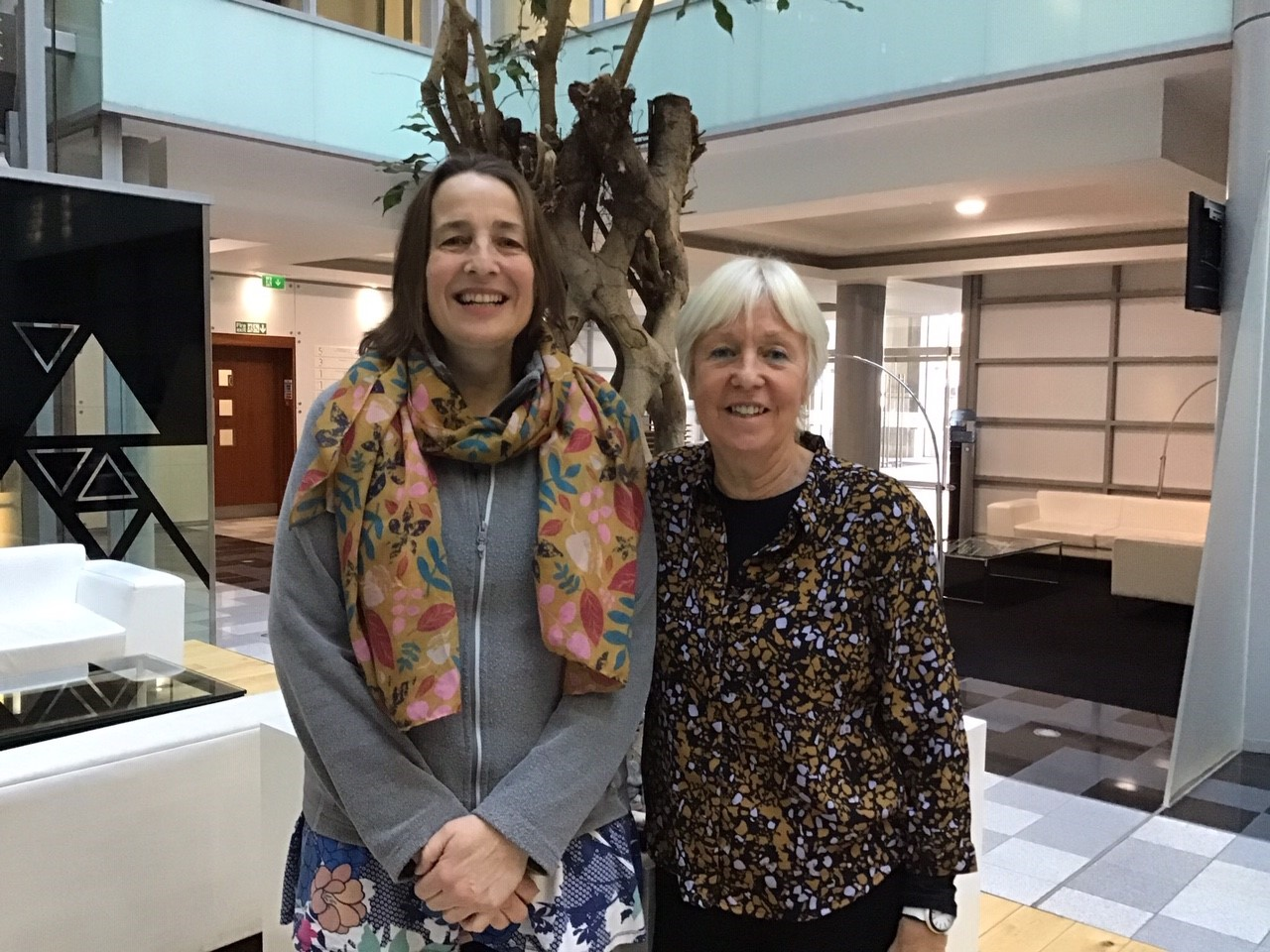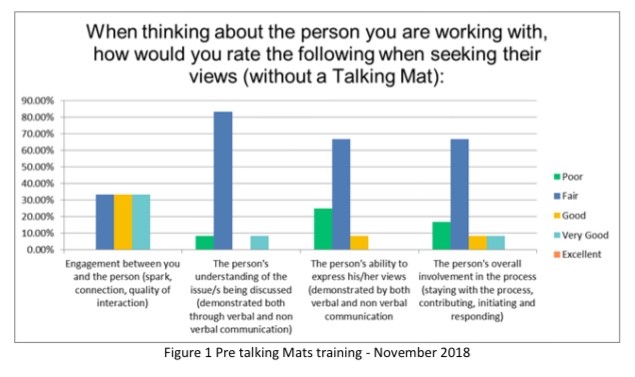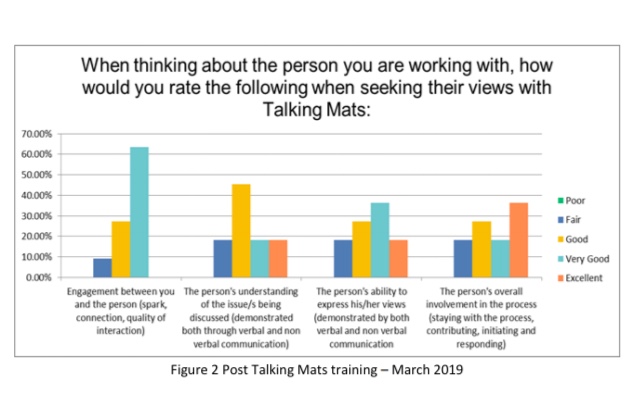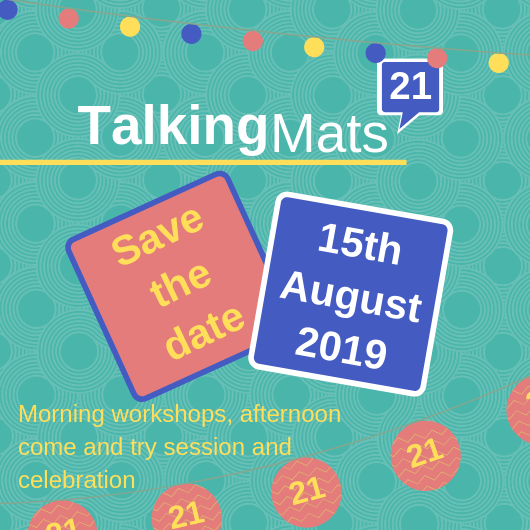We are delighted that we now have around 20 members of our Talking Mats (TM) research group. Members come from a variety of countries including the United Kingdom, Denmark, Cyprus, Germany, Sweden, Australia and Japan! We are a mix of academics and practitioners, with many combining both roles. So far we have spent time getting to know one another via video sessions and thinking about how the group might work.
We have decided our initial focus will be thinking about ways of analysing the data that is generated from conversations that are supported by TMs. This idea was suggested by Nikita Hayden. Nikita is a PhD student at the University of Warwick exploring the outcomes of siblings of children and adults with learning (intellectual) and developmental disabilities. Part of her research has used TMs with children with severe learning disabilities and their siblings to further understand their sibling relationships.
The types of data generated have been rich, vast and varied, leading to an overhaul of Nikita’s initial plan to analyse her TM data. This has raised questions about how TMs are interpreted and analysed in a research context, and what scope there is for our group to explore and synthesise the analysis potential of TMs. This is a question that the TM team is often asked and so having some information on the different options would be useful.
TM discussions generate various types of data, including:
- The photograph of the mat (which symbols are placed under the various columns);
- The conversation generated during the discussion;
- The body language and facial expression of the ‘thinker’;
- The speed of placement of symbols;
- The symbols that are moved following feedback etc.
We would like to review existing publications that have used TMs as research data and think about possible methods of analysis. This may include consideration of both within and between group research analysis techniques. It may also involve exploring the potential of both traditionally qualitative and quantitative analysis techniques, such as thematic or conversation analysis, or by drawing on data from the symbol placements to provide pre-post evaluation data.
We hope to generate a list of guidelines about what you might need to take into account when considering how to analyse these data. A challenge when analysing TMs data, is how to handle the variation in the types of data collected between participants. For example, some participants may place a large number of symbols, whereas other participants may have placed relatively few. This raises questions about how we deal with ‘missing data’. In small samples, how can we conduct a pre-post evaluation where some symbols are missing for some participants? If some participants use a five-point scale, and some use a two-point scale, what numerical analysis potential is there, if any? How can we appropriately derive qualitative themes from across our sample if some of our participants were minimally verbal? What sorts of non-verbal cues have been analysed in research using TMs?
Please do share any ideas or questions you have with Jill Bradshaw, our Talking Mats Research Associate – J.Bradshaw@kent.ac.uk
Thanks to all the people who have expressed an interest in the Talking Mats research group . We are excited to see the range of research going on and how people are using Talking Mats as a research tool in a variety of settings e.g. universities, NHS, not for profit organisations, youth justice – and with such a wide range of client groups e.g. dementia , alternative and augmentative communication , children and young people, people with learning disabilities, and palliative care.
This is a virtual network and we are still exploring ways in which this could work, but it could involve an email network, virtual seminars and/or twitter chats.
If you are interested in being included, and have completed our Talking Mats Foundation Training course, we would love to hear from you.
The network will be coordinated by Dr Joan Murphy, Founding Director of Talking Mats, and Dr Jill Bradshaw (Tizard Centre, University of Kent) who was appointed as our Honorary Associate in November 2019 https://www.talkingmats.com/honorary-research-associate/
If interested please complete and send the following form to info@talkingmats.com:
Application-to-join-TM-research-network
At Talking Mats, we offer a range of training models https://www.talkingmats.com/training/ that are tailored to suit individual teams and/or organisations and that help them develop their services to people with communication disability.
The one which best supports participants to embed Talking Mats in their practice /organisation is the Enhanced Talking Mats training https://www.talkingmats.com/training/bespoke-training-for-organisations/. This course is run over 2 days with the second day usually 4 months later supporting staff reflect, refresh and extend the implementation of Talking Mats with their clients. It includes an evaluation of the participants’ views of their interaction with ‘thinkers’ before and after the Talking Mats training. Participants are asked to complete a short questionnaire designed by the Talking Mats team on Survey Monkey prior to the first training day.
In November 2018 Joan Murphy ran the first day of an enhanced course in Welshpool, North Powys for 12 NHS staff including (Click to enlarge):
Over the next few months participants were asked to use Talking Mats and bring case studies to the follow up day. They were also asked to complete the survey before the second day which was held in March 2019.
The following graphs show the comparison of the pre- and post- training evaluations. (Double click to enlarge the figures):
Figure 1 Pre talking Mats training – November 2018
Figure 2 Post Talking Mats training – March 2019
In addition, participants were asked to add any comments. Here are a sample of them:
It allowed me to identify areas that mattered most to the person in terms of what they wanted to work on in therapy. It showed me that what I thought was the most severe aspect wasn’t always what was having the biggest impact.
- Now have understanding of hobbies/likes to interact with on the ward to engage in therapy and reduce anxiety/boredom.
- Brought up something important to them which probably would not have surfaced without TM.
- Used to make patient-centred goals as opposed to goals set with family therapist.
In conclusion, if any organisations are looking for Talking Mats training, we would encourage them to consider booking the enhanced course to support them to use Talking Mats to its best effect.
Our Talking Mats is 21 Event is in Stirling on Thursday 15th August 2019. Thanks to funding from NHS Forth Valley endowment committee the event is free but you do need to book your space https://www.eventbrite.co.uk/e/talking-mats-is-21-tickets-62362171935
You can come to the morning only, afternoon only or come for the whole day.
If you can’t come to our event watch out for out blogs and social media celebrating the reach of Talking Mats for 21 days before the 15th of August. Please join in with your contributions using the hashtag #TMis21. For 21 days after our event we will be having a special Birthday offer! Watch this space, more to follow …….
In this latest blog, our Talking Mats OT Associate, Rachel Woolcomb tells us how Talking Mats can support delivery of Personalised Care:
“Person centred practice”, and “partnership approach” are common phrases heard in health and social care settings but what does this really mean in practice?
How good are we at ensuring our service users are truly heard, and given opportunities to talk about what is important to them?
Recently NHS England set out their ambitions for the delivery of personalised care. This is a commitment to enabling people to have the same choice and control over their mental and physical health that they have come to expect in every other part of their life.
This however requires a shift in culture.
One of the cornerstones of personalised care is shared decision making. This is a collaborative process in which people are supported to understand the options available to them including the various risks, benefits and consequences. A shared decision will have acknowledged personal preferences, circumstances, values and beliefs. This ensures that when a choice is made it is fully informed.
There is substantial literature which demonstrates the usefulness of goal setting as part of the communication and decision making process.
A well written person-centred goal will describe the anticipated achievement of a specific activity. It will be meaningful and help create a common vision within the rehabilitation process.
Talking Mats is an ideal tool to help facilitate these processes. They enable better conversations and provide an interactive thinking space. They have also been demonstrated to be a useful tool in enabling people to think about their rehabilitation goals.
Read more about this in the TMOT Resource 2: How Talking Mats can help facilitate shared decision making and goal setting: Goal setting TMOT 2
If you would like to find out more about the different Talking Mats training options we offer, take a look here: https://www.talkingmats.com/training/
Rachel Woolcomb, our Talking Mats OT Associate, tells us about the recent Royal College of Occupational Therapists’ Report and considers the ways Talking Mats can support:
The Royal College of Occupational Therapists have recently published a new report. “Making personalised care a reality: The role of occupational therapy.”
As the OT Associate for Talking Mats, I took the opportunity to review the document and consider how Talking Mats can help OT’s in fulfilling the recommendations made.
The report recognises that people living with long-term conditions bring different and equally important, knowledge and expertise to the decision –making process.
It challenges OT’s to ensure that they really listen to, and hear the views of the people they work with.
A Talking Mat can help facilitate this. It helps people to understand what is being discussed, to reflect and organise their thoughts, to say what matters most to them and record their views. It helps OT’s to really listen, to learn new information, to involve the person in their own planning and support decision making.
Read more about how Talking Mats can help OT’s to make personalised care a reality in the TMOT Resource 1: TM Personalised Care – Copy.
The RCOT report is available here: https://www.rcot.co.uk/news/delivering-personalised-care-frontline
Rachel would love to hear from you if you have any examples of how Talking Mats have helped you to provide personalised care, or if you want to know more about OT and Talking Mats. Her email is: Rachel@talkingmats.com.
If you are feeling inspired and would like to find out about accessing Talking Mats Foundation Training, take a look at our upcoming courses across the UK, as well as online and organisational training options: https://www.talkingmats.com/training/
Many thanks to Mary Walsh, Health Service Executive (HSE) Senior SLT at St Mary’s Hospital, Dublin for this fantastic blog post about their project involving use of Talking Mats to support people with Dementia to participate in decision making related to their needs:
In September 2016 Aideen Lawlor (SLT Manager) and I (Senior SLT) won the Dementia Elevator award with a project entitled “Empowering Persons with Dementia to become more Active Participants in Decision Making Related to Their Present and Future Needs.” with Talking Mats being an integral part of this project. In November 2017, the prize money was used to fund my training to become an accredited Talking Mats trainer so that I could then train others in TM Foundation Course on a prioritised basis.
This project is now complete with 6 speech and language therapists (SLTs) from a variety of settings working with persons with dementia all trained in using Talking Mats. As part of their training, The SLTs used TM with patients/ residents with particular reference to the Assisted Decision Making (Capacity) Act 2015. TMs were also used to help the clinicians to get to know their patients, in care planning, in improving increased opportunities for interaction and in improving choices and decision making. In effect, we were checking it out!
All the SLTs found that when TM principles are followed, that it helped to empower people with dementia to make decisions about their care. Some of the reported findings:
- That the pictures help maintain attention and aid comprehension.
- That it facilitated strengths rather than a deficit model.
- That photographed completed TM provided a pictorial record for meetings – very positive.
- That it provided a significant catalyst for change in some instances.
- That it helped people with dementia and responsive behaviour get needs met
- That video recording sessions with consent greatly enhances reflective practice and may be helpful in key decision making
The next phase is to expand the number of SLTs who can provide training in Talking Mats across the Republic of Ireland. Funding from the national SLT professional body training grant scheme has been sought for these 6 SLTs to become trainers for Talking Mats. This will result in cascading training on a priority basis, increase evidence base/ knowledge re using TM and embedding TM in variety of clinical settings with SLTs leading this practice.
Mary Walsh,
Senior speech and language therapist,
St. Mary’s Hospital,
Phoenix Park, Dublin 20,
Ireland
Aideen Lawlor
Speech and Language Therapy Manager
If you are feeling inspired and are interested in accessing Talking Mats training, we offer Foundation Training courses throughout the UK and Ireland as well as online – take a look here for more details:
Once you have accessed Foundation Training you can apply for our Accredited Trainers course to enable you to deliver Talking Mats training to others in your area.
Huge thanks to all the practitioners who have sent us guest blogs. We selected our 10 favourite guest blogs…in no particular order!
- Talking Mats to support children who stammer Kirsten Taylor, Speech and Language Therapist tells a moving story about how finding out what was upsetting a boy with a stammer helped to implement change.
- Hearing the voice of the child Emma Atkiss, Senior Educational Psychologist, shares her findings from the Wigan Pathfinder project reporting that using a Talking Mat helps to meet the 5 criteria of Shier’s model of participation.
- Talking Mats for capacity assessments in people with ASD/LD Ruth Spilman, Senior SLT from The Cambian Group, shares practical tips on assessing capacity.
- Castle hill school supports pupil voice Jenna McCammon, SLT and Rebecca Highton, SLT Assistant, tell 3 inspiring stories using TMs in: selective mutism; safeguarding and motivational interviewing.
- Supporting Looked After Children to have their say Karen Wilson, Principal Teacher for children with additional support needs in a mainstream secondary school shares her experience of using TMs to give young people a stronger voice in making decisions affecting them.
- Hearing the voices of Looked After Children Rachel Clemow, Head Teacher and Donna Wood, Education Support Worker, report that Talking Mats has enabled children to express their thoughts and views in a safe, neutral environment.
- Talking Mats and Mental Health Carla Innes, Clinical Psychologist for learning disability from Healthy Young minds Stockport talks about the impact of TM training on the whole team.
- Mummy I don’t want to go to nursery today read about how using a Talking Mat might shed some light on why a 4 year old was upset at the thought of going to nursery.
- How do you feel about starting school? The story of 4 year old twins and their thoughts about starting school.
- Sibling Attitudes Prof Juan Bornman from Pretoria in South Africa publishes a report on a study carried out with 27 typically developing children who have a younger sibling with a severe speech and language disability.
If you have been inspired and are not yet trained to use Talking Mats – come along to one of our training courses.
Involving people with a learning disability in service evaluation is both essential and challenging.
Maria Lavery speech and language therapist, and her colleagues in North and South Lanarkshire are using Talking Mats to get feedback about the service they deliver for people with a learning disability . They want to find out about what people feel they do well, and what could be done differently. In addition they have placed a suggestion box at the entrance to their building, but want to involve everyone who is connected with their service – clients, family, carers various multi-agency colleagues and are carrying the review out over a 6 month period.
The analysis and learning will be used to inform the Speech & Language Therapy work plan and support the future direction of the service.
Talking Mats has been used successfully to evaluate Augmentative and Alternative Communication services and the resource for this is available on our website http://www.talkingmats.com/wp-content/uploads/2013/09/AAC-service-Evaluation-script-and-symbols.pdf
Laura Holmes was pleased to meet up with Rachel Clemow, Head Teacher and Donna Wood, Education Support Worker who work for the Virtual Schools Team in Wigan to find out about the impact of Talking Mats training.
Donna accessed a Talking Mats Training last year delivered by a Talking Mats accredited Trainer in Wigan Educational Psychology service and quickly put her training into practice with the children that she works with, using the Consulting Children and Young People – Primary resource pack. Other members of the team soon recognised the potential benefits of introducing this approach themselves, and so, in April 2017, a further 15 members of the Virtual Schools Team received Talking Mats training.
Looked After Children can often struggle to express their thoughts and feelings, often as a result of their situation/ circumstances. This can be further compounded if they also present with speech, language and communication difficulties. There is a higher risk of such difficulties within the LAC population (Cross 1999 ).
Often there are many professionals involved with a Looked After Child, all asking a wide variety of questions, some of which can be highly personal and/or emotive in nature. The team have observed that children will sometimes end up giving answers which they think the listener wants to hear, rather than answers which reflect their true feelings/views – or the child may withdraw from the process entirely. Consequently, it can be very difficult to ensure that the true ‘voice of the child’ is being heard. Sometimes the children themselves struggle to understand what their own feelings are – often the topics and questions can be complex and involve abstract concepts.
Rachel and Donna report that the Talking Mats approach has had a big impact on their communication style when working with the children on their caseloads, and has enabled children to express their thoughts and views in a safe, neutral environment. Some of the comments they made about Talking Mats were that it:
– Enables the listener to get to know a child quicker and more easily as there is no pressure/expectation of the ‘thinker’ – it is a child/’thinker’ led approach.
– Provides way of supporting the child to open up to express their views and feelings, even if they have previously been hard to engage – and for the child to develop better insight into their own feelings.
– Helps to avoid the possibility of adult/listener misinterpretation of what the child is trying to communicate.
– Enables the child to focus on pictures – which appears to result in the child being more comfortable in expressing their own views and feelings – as opposed to what the child thinks the listener wants to hear.
– Provides a holistic view of the child – which can support target setting and planning at key stages for that child, for example, transition to High School.
– Gives the child something they can be successful at – there are no ‘wrong’ answers.
Donna shared a great example of how Talking Mats helped a young girl to describe an issue at home which she had not shared with any carers or school staff previously. The child placed the ‘home’ option symbol on the ‘not happy’ section of the mat then began to whisper to Donna explaining the reason why. This resulted in Donna being able to share the information with school staff and social care, consequently, the issue was resolved.
Services, organisations and schools in Wigan are already using the Talking Mats approach as a result of widespread training delivered by our Accredited trainers in the Educational Psychology Team. This provides a great example of how using Talking Mats across agencies can really help a whole area to become more child/ young person led.
The Virtual Schools team are now recommending the Talking Mats approach to other agencies working with the Looked After Children on their caseloads, such as adoption and fostering services.
If want to access the training then there are Talking Mats foundation courses run regularly in London, Stirling , Manchester and Newcastle . Once you have attended a foundation training and gained experience you can apply to become an accredited trainer .
It was great to meet with Nikki Steiner, Principal Speech and Language Therapist with Central London Community Health Care Trust (CLCH), to evaluate the work that was commissioned by CLCH. The project started in the spring of 2016 and aimed to support a person-centred and inclusive approach to health planning and intervention using the Talking Mats framework.
Those words ‘person-centred’ and ‘inclusive’ are easy to say but much harder to implement. Our approach was threefold:
- We provided 100 staff with the Talking Mats resources to use in their practice (both the original and digital versions).
- We ran 3 Enhanced Talking Mats training courses for those staff which involved two days training. The first day introduced the framework and built staff confidence in using the resource. The second day supported staff to reflect on their use of the Talking Mats in their work setting, and allowed them to think creatively about further application and development.
- To sustain the capacity of CLCH to continue with the project we trained three accredited trainers. The plan is they will continue to build staff skills and training on an on-going basis and provide local leadership and expertise.
The evaluation framework that we are using looks at impact of this investment using the Kirkpatrick model of evaluation. This allowed us to evaluate:
- Participants’ reaction to the training,
- Participants’ learning – did they increase their knowledge skills and learning?
- Transfer and application – did they apply their learning to the workplace?
- Result – this was based on the impact that using the Talking Mats skills and resources had on the lives of people with communication disability
We had different measurements for each part of the model and these ranged from course feedback, a quiz, personal reflection and stories from people with communication difficulties. It is these that we are in the process of analysing so watch this space for the final report. Nikky said ‘This is such an exciting project that impacts on all the different client groups that we support’.
If you would like to discuss implementing Talking Mats at an organisational level then have a look at this link – Organisational Training
 Online training login
Online training login 









